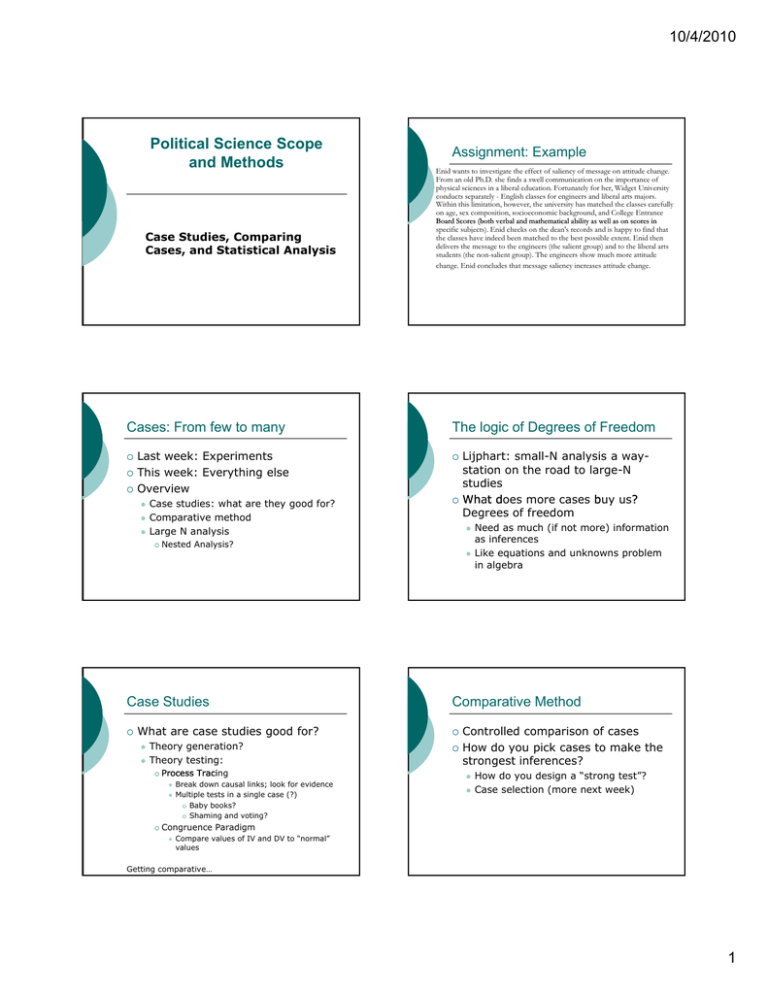Document 13654858
advertisement

10/4/2010 Political Science Scope and Methods Case Studies, Comparing Cases, and Statistical Analysis Cases: From few to many Last week: Experiments This week: Everything else Overview Case studies: what are they good for? Comparative method Large N analysis Assignment: Example Enid wants to investigate the effect of saliency of message on attitude change. From an old Ph.D. she finds a swell communication on the importance of physical sciences in a liberal education. Fortunately for her, Widget University conducts separately - English classes for engineers and liberal arts majors. Within this limitation, however, the university has matched the classes carefully on age, sex composition, socioeconomic background, and College Entrance Board Scores (both verbal and mathematical ability as well as on scores in specific subjects). Enid checks on the dean's records and is happy to find that the classes have indeed been matched to the best possible extent. Enid then delivers the message to the engineers (the salient group) and to the liberal arts students (the non-salient group). The engineers show much more attitude change. Enid concludes that message saliency increases attitude change. The logic of Degrees of Freedom Lijphart: small-N analysis a waystation on the road to large-N studies What does more cases b buy us? Wh t d ? Degrees of freedom Nested Analysis? Case Studies What are case studies good for? Theory generation? Theory testing: Process Tracing Tracing Break down causal links; look for evidence Multiple tests in a single case (?) Baby books? Shaming and voting? Need as much (if not more) information as inferences Like equations and unknowns problem in algebra Comparative Method Controlled comparison of cases How do you pick cases to make the strongest inferences? How do you design a “strong test”? Case selection (more next week) Congruence Paradigm Compare values of IV and DV to “normal” values Getting comparative… 1 10/4/2010 Strategies of Controlled Comparison Most different vs. most similar “Method of difference” Case Study Example: Assuming the Costs of War Select cases that are as similar as possibl ible exceptt iin their i value l on th the IV of interest “Method of agreement” Select cases that similar on IV, but different in other ways Examine effect of elite discourse on structure of public opinion concerning war Case studies: 4 cases (and 2-5 observations within each case) World War II: 1939-1941 World War II: 1940 Election World War II: 1942-1945 Iraq War: July-August 2004 Comparisons: “Method of difference” “Method of agreement.” 1939-1941 vs. 1940 Election 1942-1945 vs. 2004 Questions of robustness Example: Iraq War Please give your best guess to this next question, even if you are not sure of the correct answer. As you know, the United States is currently involved in a war in Iraq. Do you happen to k how many soldi ldiers t know of the U.S. military have been killed in Iraq since the fighting began in March 2003? Examining outliers Liberman’s Nested Strategy In random data 5% of relationships appear significant Account for competing theories Look at independent data sets Log (Base 10) of Estimates of U.S. Troop Deaths in Iraq, 2004 .5 Art and science Understanding your analysis .4 Report uncertainty .3 Be mindful of C&S’s threats to QuasiExperiments Be honest about results Fraction .2 Internal vs. External validity tradeoff .1 0 Large N (Statistical) Analysis Large N (Statistical) Analysis (Cont.) 0 1 2 3 Log(10) Casualties 4 5 2 10/4/2010 Image removed due to copyright restrictions. Please see Tables 2, 3, & 4 in: Berinsky, Adam. "Assuming the Costs of War: Events, Elites, and American Public Support for Military Conflict." The Journal of Politics 69, no.4 (2007): 975-997.�� Image removed due to copyright restrictions. Please see Tables 2, 3, & 4 in: Berinsky, Adam. "Assuming the Costs of War: Events, Elites, and American Public Support for Military Conflict." The Journal of Politics 69, no.4 (2007): 975-997.�� Image removed due to copyright restrictions. Please see Tables 2, 3, & 4 in: Berinsky, Adam. "Assuming the Costs of War: Events, Elites, and American Public Support for Military Conflict." The Journal of Politics 69, no.4 (2007): 975-997.�� 3 MIT OpenCourseWare http://ocw.mit.edu 17.869 Political Science Scope and Methods Fall 2010 For information about citing these materials or our Terms of Use, visit: http://ocw.mit.edu/terms.



